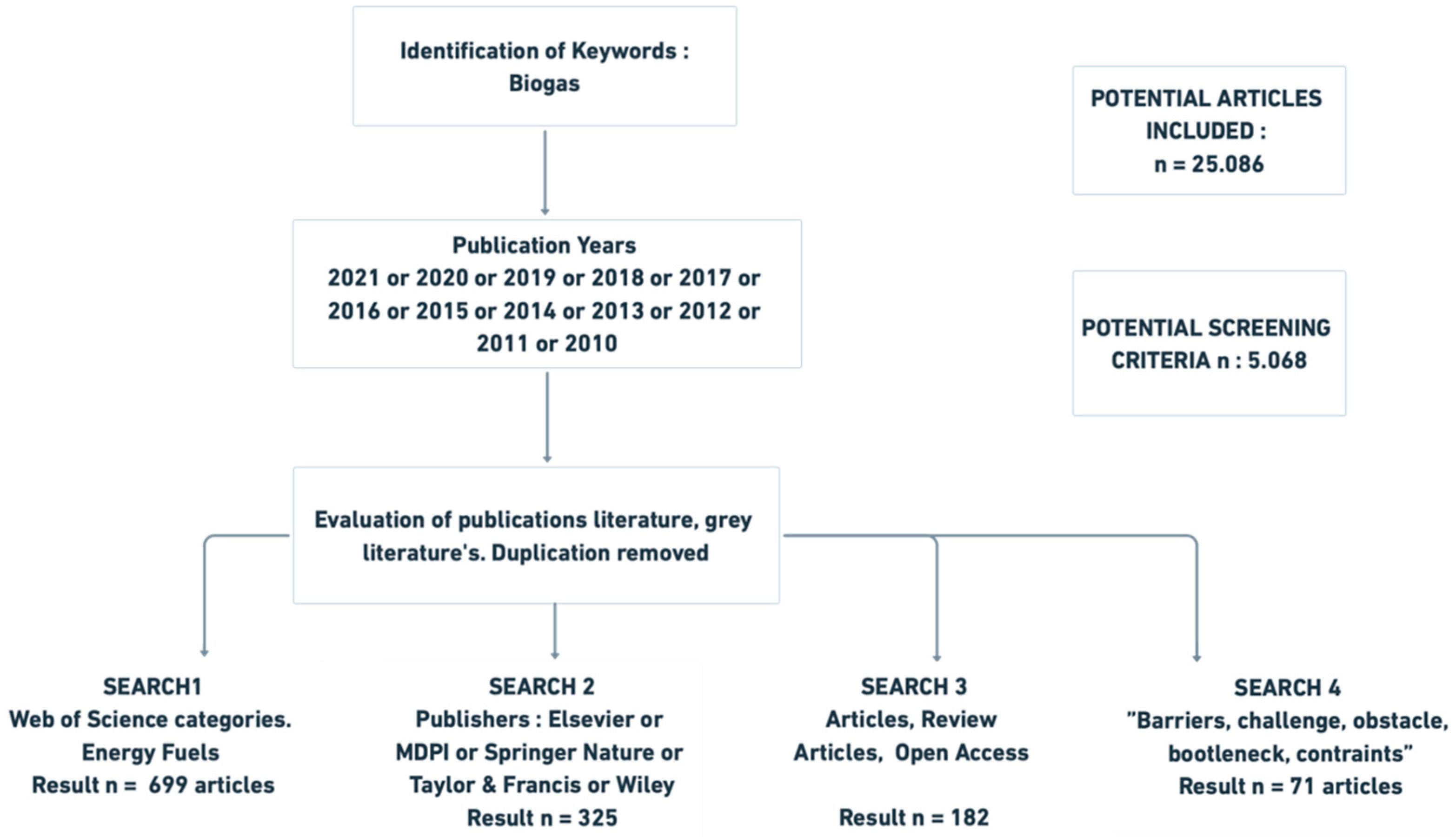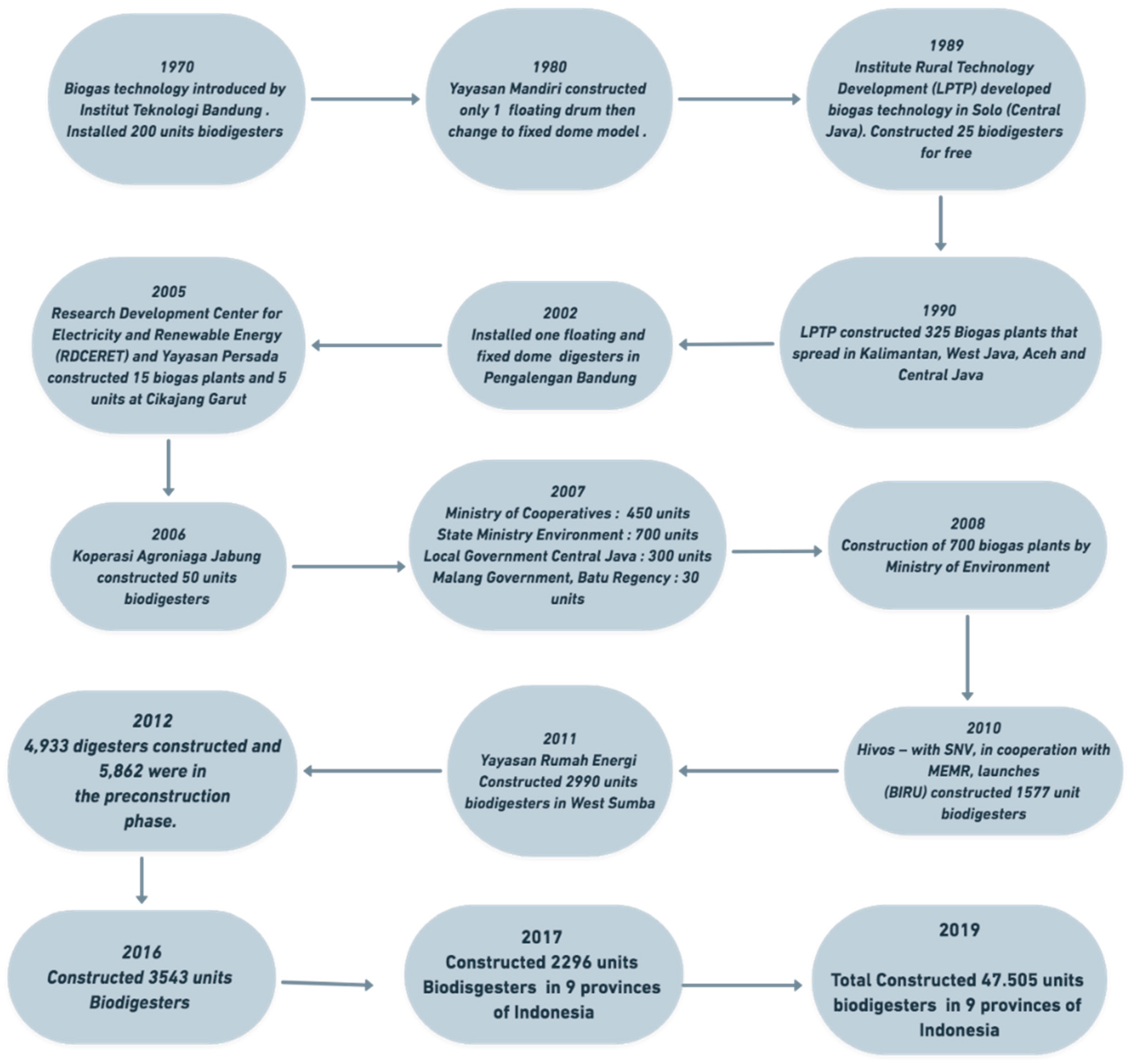Technological, Economic, Social and Environmental Barriers to Adoption of Small-Scale Biogas Plants: Case of Indonesia
Abstract
:1. Introduction
2. Materials and Methods
2.1. Methodology
- To find relevant literature, Web of Science was used. We used the identification keyword, biogas, to start with the elimination of articles. The number of potential articles included in the first screening process was 25.086 articles.
- Mendeley was used to extract each publication’s title, abstract, and keywords utilized in publications between 2010 and 2021. Several types of papers were discovered in the retrieved publications, including articles, reviews, and articles in the press. There were 5068 articles found when the first search step was the year of publications. Figure 3 explained about the publications and citations trend from year 2013–2021 as the most cited from this study, while in 2010, 2011, 2012 and 2022 are the least cited year [27].
- The next step, Search 1, was used to retrieve the article web of science with energy fuels categories, which were document-type articles or review articles, with a result of 699 articles. Web of Science (WoS) was used as the primary database to retrieve the examined papers. Due to the high proportion of exclusive journals, Gao et al. [28] recommended the WoS database for social sciences. Moreover, the database gained a high reputation and recognition in the scientific community, becoming a primary source of citation data. As a result, WoS appears to be a better fit for searching and analysing scientific literature at the publication level. WoS was chosen because of its journals’ impact factor in the Journal Citation Report (JCR) ranks, the most well-known bibliographic database. [24,25,26,28].
- To arrive at specific and reputable articles, we selected further articles, review articles and open access articles. As a result, as shown in Figure 2, Search 3 (article in press) yielded 182 results.
- In the fourth step, Search 4 was used to classify existing challenges to widespread biogas use, including keywords “barriers”, “challenges”, “obstacle”, “bottleneck”, and “constraints”, in order to identify and remove potential adoption barriers. As a result, we discovered 71 articles discussing the adoption of biogas or the difficulties faced by emerging nations. When statistical analysis cannot be used to interpret the data, content analysis fills in the gaps. This approach frequently combines an inductive or deductive procedure with either qualitative or quantitative data [26,28].
2.2. Indonesia’s Biogas Development
3. Results
3.1. Finding 1: Technical Barriers
3.2. Finding 2: Financial and Economic Barriers
3.3. Finding 3: Social and Cultural Barriers
3.4. Finding 4: Environmental Barriers
3.5. An Indonesian Biogas Adoption Recommendations
3.5.1. Policy Recommendation
3.5.2. Transfer Knowledge and Capacity Building
3.5.3. Subsidies and Government Assistance
4. Conclusions and Limitations
Author Contributions
Funding
Institutional Review Board Statement
Informed Consent Statement
Data Availability Statement
Conflicts of Interest
References
- Vorley, B.; Porras, I.T.; Amrein, A. The Indonesia Domestic Biogas Programme: Can Carbon Financing Promote Sustainable Agriculture? International Institute for Environment and Development: London, UK, 2015; ISBN 978-1-78431-220-6. Available online: https://cgspace.cgiar.org/handle/10947/186 (accessed on 23 May 2022).
- Wahyudi, J. The Determinant Factors of Biogas Technology Adoption in Cattle Farming: Evidence from Pati, Indonesia. Int. J. Renew. Energy Dev. 2017, 6, 235–240. [Google Scholar] [CrossRef] [Green Version]
- Praditya, A.; Abdilla, T.; Damayanti, A.H.; Marciano, I.; Simamora, P.; Mursanti, E.; Arinaldo, D.; Giwangkara, J.; Adiatma, J.C. Indonesia Clean Energy Outlook Tracking Progress and Review of Clean Energy Development in Indonesia; Institute for Essential Services Reform: Jakarta Selatan, Indonesia, 2019. [Google Scholar]
- Bond, T.; Templeton, M.R. History and Future of Domestic Biogas Plants in the Developing World. Energy Sustain. Dev. 2011, 15, 347–354. [Google Scholar] [CrossRef]
- Putra, R.A.R.S.; Liu, Z.; Lund, M. The Impact of Biogas Technology Adoption for Farm Households–Empirical Evidence from Mixed Crop and Livestock Farming Systems in Indonesia. Renew. Sustain. Energy Rev. 2017, 74, 1371–1378. [Google Scholar] [CrossRef]
- Mwirigi, J.; Balana, B.B.; Mugisha, J.; Walekhwa, P.; Melamu, R.; Nakami, S.; Makenzi, P. Socio-Economic Hurdles to Widespread Adoption of Small-Scale Biogas Digesters in Sub-Saharan Africa: A Review. Biomass Bioenergy 2014, 70, 17–25. [Google Scholar] [CrossRef]
- Kabir, H.; Yegbemey, R.N.; Bauer, S. Factors Determinant of Biogas Adoption in Bangladesh. Renew. Sustain. Energy Rev. 2013, 28, 881–889. [Google Scholar] [CrossRef]
- Kamp, L.M.; Bermúdez Forn, E. Ethiopia׳s Emerging Domestic Biogas Sector: Current Status, Bottlenecks and Drivers. Renew. Sustain. Energy Rev. 2016, 60, 475–488. [Google Scholar] [CrossRef] [Green Version]
- Mengistu, M.G.; Simane, B.; Eshete, G.; Workneh, T.S. Factors Affecting Households’ Decisions in Biogas Technology Adoption, the Case of Ofla and Mecha Districts, Northern Ethiopia. Renew. Energy 2016, 93, 215–227. [Google Scholar] [CrossRef]
- Kelebe, H.E. Returns, Setbacks, and Future Prospects of Bio-Energy Promotion in Northern Ethiopia: The Case of Family-Sized Biogas Energy. Energy Sustain. Soc. 2018, 8, 30. [Google Scholar] [CrossRef]
- Katuwal, H.; Bohara, A.K. Biogas: A Promising Renewable Technology and Its Impact on Rural Households in Nepal. Renew. Sustain. Energy Rev. 2009, 13, 2668–2674. [Google Scholar] [CrossRef]
- Rao, P.V.; Baral, S.S.; Dey, R.; Mutnuri, S. Biogas Generation Potential by Anaerobic Digestion for Sustainable Energy Development in India. Renew. Sustain. Energy Rev. 2010, 14, 2086–2094. [Google Scholar] [CrossRef]
- Rupf, G.V.; Bahri, P.A.; de Boer, K.; McHenry, M.P. Barriers and Opportunities of Biogas Dissemination in Sub-Saharan Africa and Lessons Learned from Rwanda, Tanzania, China, India, and Nepal. Renew. Sustain. Energy Rev. 2015, 52, 468–476. [Google Scholar] [CrossRef] [Green Version]
- Budiman, I.; Muthahhari, R.; Kaynak, C.; Reichwein, F.; Zhang, W. Multiple Challenges and Opportunities for Biogas Dissemination in Indonesia. Indones. J. Energy 2018, 1, 46–60. [Google Scholar] [CrossRef]
- Roubík, H.; Mazancová, J. Suitability of Small-Scale Biogas Systems Based on Livestock Manure for the Rural Areas of Sumatra. Environ. Dev. 2020, 33, 100505. [Google Scholar] [CrossRef]
- van Nes, W.J.; Tumiwa, F.; Setyadi, I. Feasibility of a National Programme on Domestic Biogas in Indonesia Final Report SNV Netherlands Development Organisation; SNV: The Hague, The Netherlands, 2009. [Google Scholar]
- Budiman, I. The Tangled Thread: Fragmentation of Biogas Governance in Indonesia; Wageningen University & Research eDepot—WUR: Wageningen, The Netherlands, 2018. [Google Scholar]
- Indonesia Energy Outlook 2017. Secretariat General National Energy Council; ISSN Z527-3000. Available online: www.den.go.id (accessed on 23 May 2022).
- Taylor, R.; Devisscher, T.; Silaen, M.; Yuwono, Y.; Ismail, C.; Thamrin, S.; Takama, T. Risks, Barriers and Responses to Indonesia’s Biogas Development; SEI Discussion Brief; Stockholm Environment Institute: Stockholm, Sweden, 2019. [Google Scholar]
- Bößner, S.; Devisscher, T.; Suljada, T.; Ismail, C.J.; Sari, A.; Mondamina, N.W. Barriers and Opportunities to Bioenergy Transitions: An Integrated, Multi-Level Perspective Analysis of Biogas Uptake in Bali. Biomass Bioenergy 2019, 122, 457–465. [Google Scholar] [CrossRef]
- Bekchanov, M.; Mondal, M.A.H.; de Alwis, A.; Mirzabaev, A. Why adoption is slow despite promising potential of biogas technology for improving energy security and mitigating climate change in Sri Lanka? Renew. Sustain. Energy Rev. 2019, 105, 378–390. [Google Scholar] [CrossRef]
- Shen, G.; Lin, W.; Chen, Y.; Yue, D.; Liu, Z.; Yang, C. Factors Influencing the Adoption and Sustainable Use of Clean Fuels and Cookstoves in China-a Chinese Literature Review. Renew. Sustain. Energy Rev. 2015, 51, 741–750. [Google Scholar] [CrossRef]
- Torres-Carrión, P.V.; González-González, C.S.; Aciar, S.; Rodríguez-Morales, G. Methodology for Systematic Literature Review Applied to Engineering and Education. In Proceedings of the 2018 IEEE Global Engineering Education Conference (EDUCON), Santa Cruz de Tenerife, Canary Islands, Spain, 17–20 April 2018; pp. 1364–1373. [Google Scholar]
- Falagas, M.E.; Pitsouni, E.I.; Malietzis, G.A.; Pappas, G. Comparison of PubMed, Scopus, Web of Science, and Google Scholar: Strengths and Weaknesses. FASEB J. 2008, 22, 338–342. [Google Scholar] [CrossRef]
- Maggio, L.A.; Sewell, J.L.; Artino, A.R., Jr. The Literature Review: A Foundation for High-Quality Medical Education Research. J. Grad. Med. Educ. 2016, 8, 297–303. [Google Scholar] [CrossRef] [Green Version]
- Larivière, V.; Haustein, S.; Mongeon, P. The Oligopoly of Academic Publishers in the Digital Era. PLoS ONE 2015, 10, e0127502. [Google Scholar] [CrossRef]
- Mandeley Reference Manager. Mandeley Graph, 2022. Available online: https://www.mendeley.com/search (accessed on 23 May 2022).
- Gao, H.; Ding, X.-H.; Wu, S. Exploring the Domain of Open Innovation: Bibliometric and Content Analyses. J. Clean. Prod. 2020, 275, 122580. [Google Scholar] [CrossRef]
- Carlson, K.M.; Curran, L.M.; Asner, G.P.; Pittman, A.M.; Trigg, S.N.; Marion Adeney, J. Carbon Emissions from Forest Conversion by Kalimantan Oil Palm Plantations. Nat. Clim. Chang. 2013, 3, 283–287. [Google Scholar] [CrossRef]
- Climate Action Tracker: Scaling up Climate Action Series Full Report. New Climate—Institute for Climate Policy and Global Sustainability gGmbH, 2019. Available online: www.newclimate.org (accessed on 23 May 2022).
- Satyakti, Y. Global Green Growth: Clean Energy Industrial Investments and Expanding Job Opportunities Experiences of Brazil, Germany, Indonesia, the Republic of Korea and South Africa; Padjadjaran University: Bandung, Indonesia, 2017. [Google Scholar]
- Mahmoody, F.; Sharafmal, F.; Razafindrakoto, H.; Dhakal, N.; Ayuthia, I. Knowledge Exchange on Extracting Best Practices on Renewable Energy within South-South and Triangular Cooperation Framework. A Brief Summary of Good Practices and Challenges on Renewable Energy Development in Afghanistan, Indonesia, Madagascar and Nepal; Joint Indonesian German Project; GIZ: Bonn, Germany, 2021. [Google Scholar]
- Transrisk Project. Biogas Development in Indonesia: Household Scale Evaluation of Indonesian Transition Pathways in Biogas Utilisation. JIQ Magazine. TRANSrisk Project. 2016. Available online: https://www.google.com.hk/url?sa=t&rct=j&q=&esrc=s&source=web&cd=&cad=rja&uact=8&ved=2ahUKEwjaobH09-r4AhWJCIgKHYRBCvoQFnoECAYQAQ&url=http%3A%2F%2Ftransrisk-project.eu%2Fsites%2Fdefault%2Ffiles%2FJIQ_Special_Nov2016_TRANSrisk_biogas_pathways_Indonesia.pdf&usg=AOvVaw2TIwDjX4SfaBxPZkGGG3pr (accessed on 23 May 2022).
- Asian Development Bank. Independent Assessment of Indonesia’s Energy Infrastructure Sector; Asian Development Bank: Metro Manila, Philippines, 2020. [Google Scholar]
- Rianawati, E.; Sagala, S.; Hafiz, I.; Anhorn, J.; Alemu, S.; Hilbert, J.; Rosslee, D.; Mohammed, M.; Salie, Y.; Rutz, D.; et al. The Potential of Biogas in Energy Transition in Indonesia. IOP Conf. Ser. Mater. Sci. Eng. 2021, 1143, 012031. [Google Scholar] [CrossRef]
- Laramee, J.; Davis, J. Economic and Environmental Impacts of Domestic Bio-Digesters: Evidence from Arusha, Tanzania. Energy Sustain. Dev. 2013, 17, 296–304. [Google Scholar] [CrossRef]
- Mittal, S.; Ahlgren, E.O.; Shukla, P.R. Future Biogas Resource Potential in India: A Bottom-up Analysis. Renew. Energy 2019, 141, 379–389. [Google Scholar] [CrossRef]
- Bedi, A.S.; Sparrow, R.; Tasciotti, L. The Impact of a Household Biogas Programme on Energy Use and Expenditure in East Java. Energy Econ. 2017, 68, 66–76. [Google Scholar] [CrossRef]
- Aitken, D.; Rivera, D.; Godoy-Faúndez, A.; Holzapfel, E. Water Scarcity and the Impact of the Mining and Agricultural Sectors in Chile. Sustainability 2016, 8, 128. [Google Scholar] [CrossRef] [Green Version]
- Lantz, M.; Svensson, M.; Björnsson, L.; Börjesson, P. The Prospects for an Expansion of Biogas Systems in Sweden—Incentives, Barriers and Potentials. Energy Policy 2007, 35, 1830–1843. [Google Scholar] [CrossRef]
- Chien Bong, C.P.; Ho, W.S.; Hashim, H.; Lim, J.S.; Ho, C.S.; Peng Tan, W.S.; Lee, C.T. Review on the Renewable Energy and Solid Waste Management Policies towards Biogas Development in Malaysia. Renew. Sustain. Energy Rev. 2017, 70, 988–998. [Google Scholar] [CrossRef]
- Kabera, T.; Nishimwe, H.; Imanantirenganya, I.; Mbonyi, M.K. Impact and Effectiveness of Rwanda’s National Domestic Biogas Programme. Int. J. Environ. Stud. 2016, 73, 402–421. [Google Scholar] [CrossRef]
- Bhat, P.R.; Chanakya, H.N.; Ravindranath, N.H. Biogas Plant Dissemination: Success Story of Sirsi, India. Energy Sustain. Dev. 2001, 5, 39–46. [Google Scholar] [CrossRef]
- Biogas Rumah (BIRU). Indonesia Domestic Biogas Program 2018 Annual Report; Yayasan Rumah Energi: Jakarta Selatan, Indonesia; Available online: www.rumahenergi.org (accessed on 23 May 2022).
- Silaen, M.; Taylor, R.; Bößner, S.; Anger-Kraavi, A.; Chewpreecha, U.; Badinotti, A.; Takama, T. Lessons from Bali for Small-Scale Biogas Development in Indonesia. Environ. Innov. Soc. Transit. 2020, 35, 445–459. [Google Scholar] [CrossRef]
- Arshad, M.; Bano, I.; Khan, N.; Shahzad, M.I.; Younus, M.; Abbas, M.; Iqbal, M. Electricity Generation from Biogas of Poultry Waste: An Assessment of Potential and Feasibility in Pakistan. Renew. Sustain. Energy Rev. 2018, 81, 1241–1246. [Google Scholar] [CrossRef]
- Song, Z.; Zhang, C.; Yang, G.; Feng, Y.; Ren, G.; Han, X. Comparison of Biogas Development from Households and Medium and Large-Scale Biogas Plants in Rural China. Renew. Sustain. Energy Rev. 2014, 33, 204–213. [Google Scholar] [CrossRef]
- Yasar, A.; Nazir, S.; Tabinda, A.B.; Nazar, M.; Rasheed, R.; Afzaal, M. Socio-Economic, Health and Agriculture Benefits of Rural Household Biogas Plants in Energy Scarce Developing Countries: A Case Study from Pakistan. Renew. Energy 2017, 108, 19–25. [Google Scholar] [CrossRef]
- Khan, E.U.; Martin, A.R. Review of Biogas Digester Technology in Rural Bangladesh. Renew. Sustain. Energy Rev. 2016, 62, 247–259. [Google Scholar] [CrossRef] [Green Version]
- Landi, M.; Sovacool, B.K.; Eidsness, J. Cooking with Gas: Policy Lessons from Rwanda’s National Domestic Biogas Program (NDBP). Energy Sustain. Dev. 2013, 17, 347–356. [Google Scholar] [CrossRef]
- Tumutegyereize, P.; Muwanguzi, S.; Ayaa, F.; Kizito, S.; Wanyama, J. Effect of Thermal Shock on the Grates of Improved Charcoal Cook-Stoves Made from Different Materials. Energy Sustain. Dev. 2021, 64, 59–64. [Google Scholar] [CrossRef]
- Walekhwa, P.N.; Mugisha, J.; Drake, L. Biogas Energy from Family-Sized Digesters in Uganda: Critical Factors and Policy Implications. Energy Policy 2009, 37, 2754–2762. [Google Scholar] [CrossRef]
- Surendra, K.C.; Takara, D.; Hashimoto, A.G.; Khanal, S.K. Biogas as a Sustainable Energy Source for Developing Countries: Opportunities and Challenges. Renew. Sustain. Energy Rev. 2014, 31, 846–859. [Google Scholar] [CrossRef]
- Deng, Y.; Xu, J.; Liu, Y.; Mancl, K. Biogas as a Sustainable Energy Source in China: Regional Development Strategy Application and Decision Making. Renew. Sustain. Energy Rev. 2014, 35, 294–303. [Google Scholar] [CrossRef]
- Nevzorova, T.; Kutcherov, V. Barriers to the Wider Implementation of Biogas as a Source of Energy: A State-of-the-Art Review. Energy Strategy Rev. 2019, 26, 100414. [Google Scholar] [CrossRef]
- International Renewable Energy Agency. Biogas for Road Vehicles: Technology Brief; International Renewable Energy Agency (IRENA): Abu Dhabi, United Arab Emirates, 2018; ISBN 978-92-9260-060-0. [Google Scholar]
- Chen, Y.; Hu, W.; Feng, Y.; Sweeney, S. Status and Prospects of Rural Biogas Development in China. Renew. Sustain. Energy Rev. 2014, 39, 679–685. [Google Scholar] [CrossRef]
- Hu, Y.; Cheng, H.; Tao, S. Environmental and Human Health Challenges of Industrial Livestock and Poultry Farming in China and Their Mitigation. Environ. Int. 2017, 107, 111–130. [Google Scholar] [CrossRef] [PubMed]
- Martin, M. Potential of Biogas Expansion in Sweden: Identifying the Gap between Potential Studies and Producer Perspectives. Biofuels 2015, 6, 233–240. [Google Scholar] [CrossRef]
- Ammenb§erg, J.; Anderberg, S.; Lönnqvist, T.; Grönkvist, S.; Sandberg, T. Biogas in the Transport Sector—Actor and Policy Analysis Focusing on the Demand Side in the Stockholm Region. Resour. Conserv. Recycl. 2018, 129, 70–80. [Google Scholar] [CrossRef]
- Biogas Rumah (BIRU). Indonesia Domestic Biogas Programme Annual Report 2019; Yayasan Rumah Energi: Jakarta Selatan, Indonesia, 2019; Available online: www.rumahenergi.org (accessed on 23 May 2022).
- Gu, B.; Fan, L.; Ying, Z.; Xu, Q.; Luo, W.; Ge, Y.; Scott, S.; Chang, J. Socioeconomic Constraints on the Technological Choices in Rural Sewage Treatment. Environ. Sci. Pollut. Res. 2016, 23, 20360–20367. [Google Scholar] [CrossRef]
- Mukeshimana, M.C.; Zhao, Z.-Y.; Ahmad, M.; Irfan, M. Analysis on Barriers to Biogas Dissemination in Rwanda: AHP Approach. Renew. Energy 2021, 163, 1127–1137. [Google Scholar] [CrossRef]
- Mahachi, D.; Mokgalo, L.L.; Pansiri, J. Exploitation of Renewable Energy in the Hospitality Sector: Case Studies of Gaborone Sun and the Cumberland Hotel in Botswana. Int. J. Hosp. Tour. Adm. 2015, 16, 331–354. [Google Scholar] [CrossRef]
- Lönnqvist, J.-E.; Verkasalo, M.; Walkowitz, G.; Wichardt, P.C.; Crawford, V.; Dohmen, T.; Falk, A.; Fehr, E.; Harri-son, G.; Hennig-Schmidt, H.; et al. Measuring Individual Risk Attitudes in the Lab: Task or Ask? An Empirical Comparison*. J. Econ. Behav. Organ 2015, 119, 254–266. [Google Scholar] [CrossRef] [Green Version]
- Wrzesińska-Jędrusiak, E.; Muradin, M.; Herkowiak, M.; Łaska-Zieja, B.; Myczko, A. Environmental Performance of the Innovative, Patented Mixing System in an Agricultural Biogas Plant Based on LCA Approach. J. Clean. Prod. 2022, 349, 131420. [Google Scholar] [CrossRef]
- Mata-Alvarez, J.; Macé, S.; Llabrés, P. Anaerobic Digestion of Organic Solid Wastes. An Overview of Research Achievements and Perspectives. Bioresour. Technol. 2000, 74, 3–16. [Google Scholar] [CrossRef]
- Olsson, L.; Fallde, M. Waste(d) Potential: A Socio-Technical Analysis of Biogas Production and Use in Sweden. J. Clean. Prod. 2015, 98, 107–115. [Google Scholar] [CrossRef] [Green Version]
- Shang, M.; Hou, H. Studies on Effect of Peracetic Acid Pretreatment on Anaerobic Fermentation Biogas Production from Sludge. In Proceedings of the 2009 Asia-Pacific Power and Energy Engineering Conference, Wuhan, China, 27–31 March 2009; pp. 1–3. [Google Scholar]
- Karakashev, D.; Batstone, D.J.; Angelidaki, I. Influence of Environmental Conditions on Methanogenic Compositions in Anaerobic Biogas Reactors. Appl. Environ. Microbiol. 2005, 71, 331–338. [Google Scholar] [CrossRef] [PubMed] [Green Version]
- Gupta, P.; Shekhar Singh, R.; Sachan, A.; Vidyarthi, A.S.; Gupta, A. A Re-Appraisal on Intensification of Biogas Production. Renew. Sustain. Energy Rev. 2012, 16, 4908–4916. [Google Scholar] [CrossRef]
- Chakraborti, R.K.; Guha, D. Biogas: An Overview and the Role of Enzyme Extract and Anchored Enzymes in Enhanced and Methane-Enriched Biogas Generation. Res. Ind. 1991, 36, 114–123. [Google Scholar]
- Spaargaren, G. Theories of Practices: Agency, Technology, and Culture: Exploring the Relevance of Practice Theories for the Governance of Sustainable Consumption Practices in the New World-Order. Glob. Environ. Chang. 2011, 21, 813–822. [Google Scholar] [CrossRef]
- Poeschl, M.; Ward, S.; Owende, P. Prospects for Expanded Utilization of Biogas in Germany. Renew. Sustain. Energy Rev. 2010, 14, 1782–1797. [Google Scholar] [CrossRef]
- Dahlin, J.; Herbes, C.; Nelles, M. Biogas Digestate Marketing: Qualitative Insights into the Supply Side. Resour. Conserv. Recycl. 2015, 104, 152–161. [Google Scholar] [CrossRef]
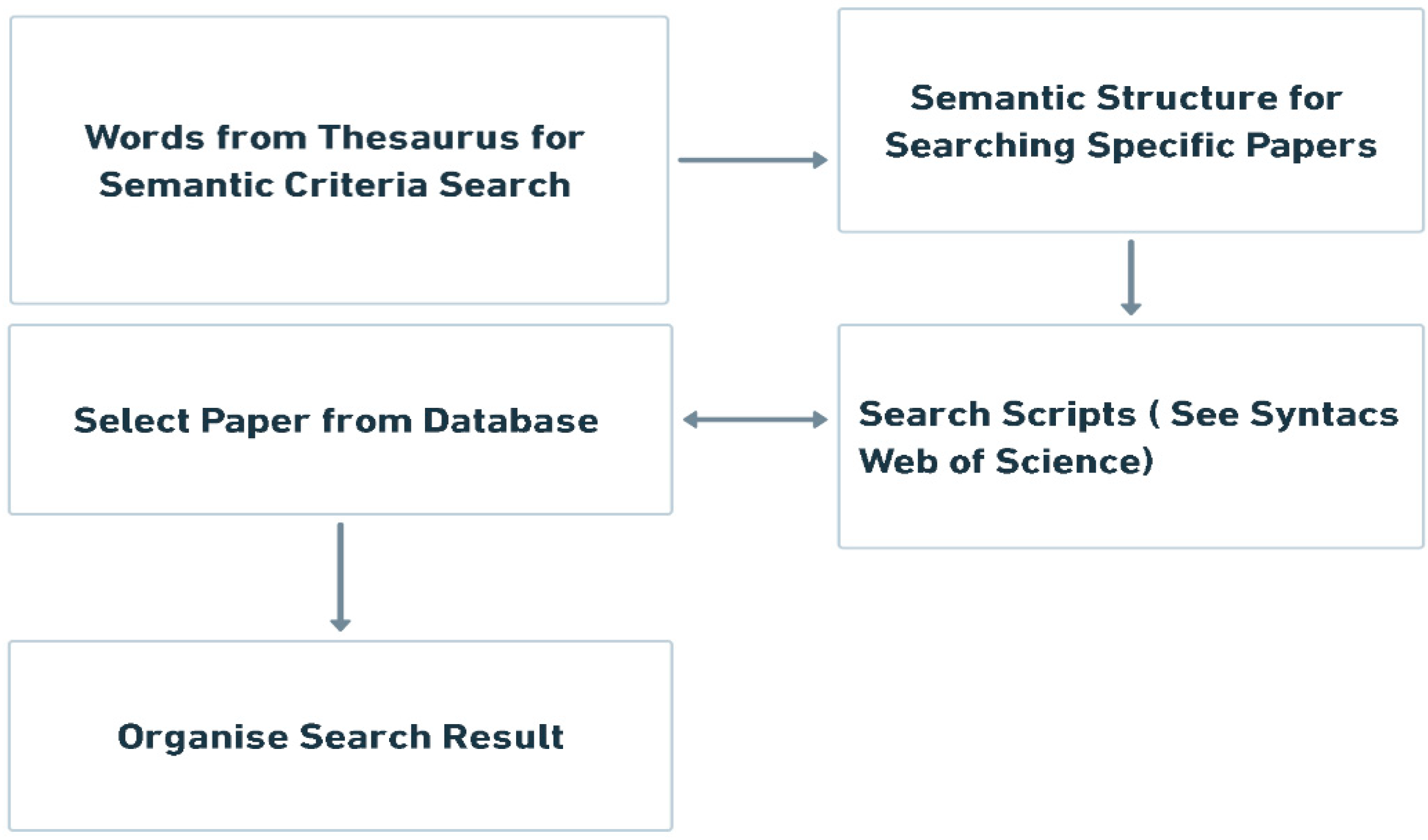
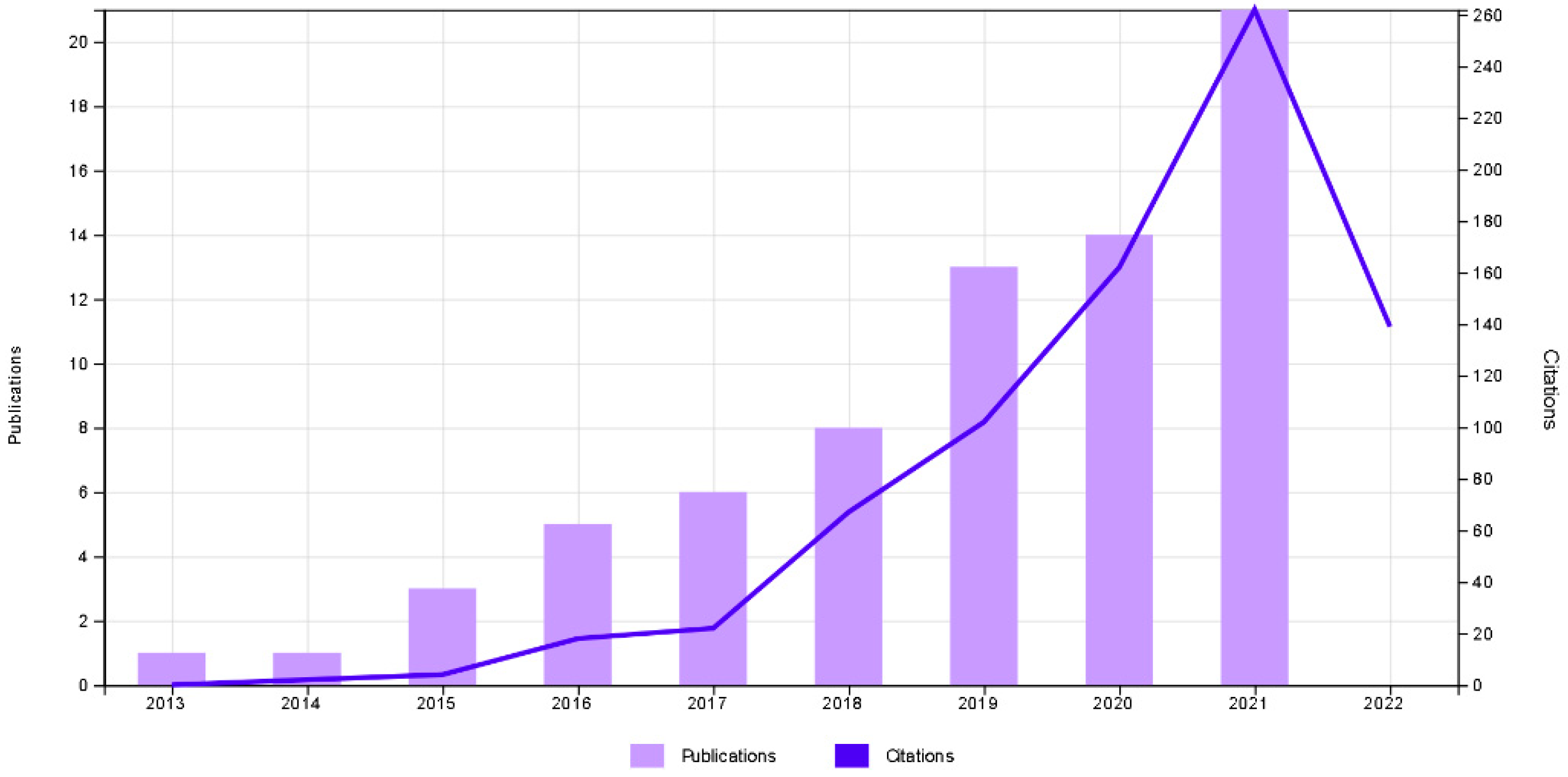
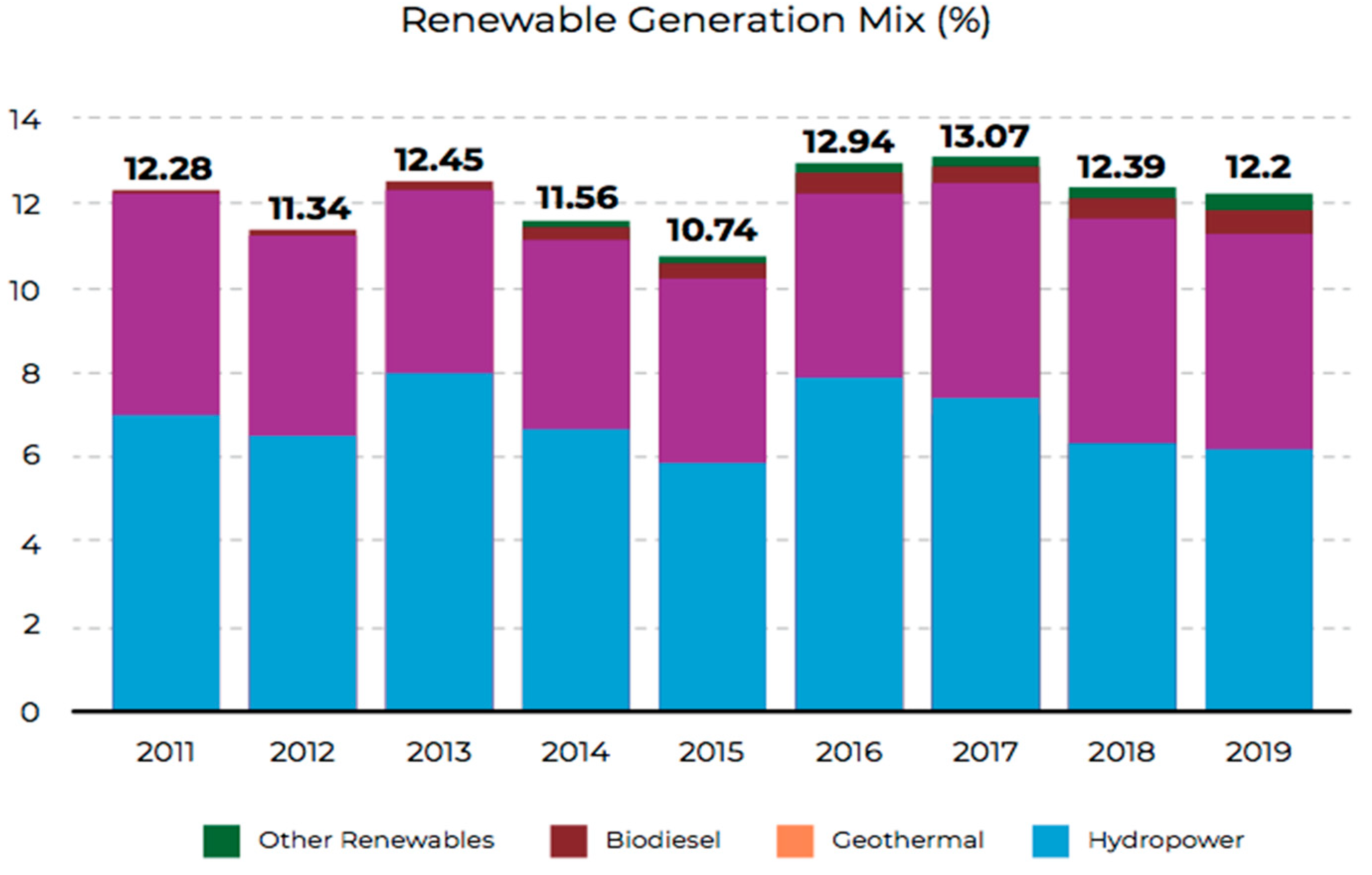
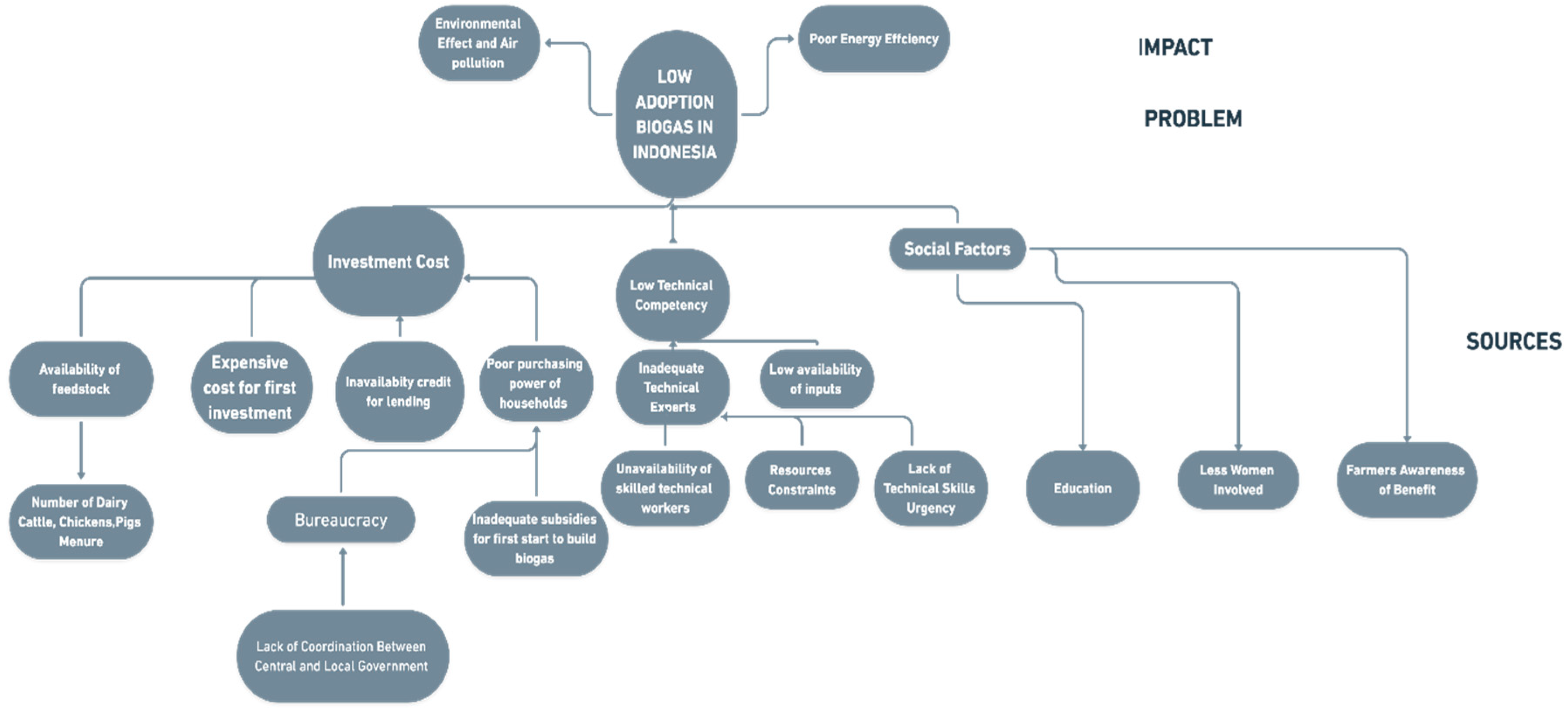
| No. | Technical Barriers Description | References |
|---|---|---|
| 1 | Lack of standard quality and control measures | [18,35,40,41] |
| 2 | Inadequate design and construction | [1,14,41,42] |
| 3 | Technical knowledge and training are lacking | [30,34,40,43,44,45] |
| 4 | Insufficient feedstock | [34,40,44,45,46] |
| 5 | Local research is lacking for tailor-made technology and context | [14,40,47,48] |
| 6 | Lack of biogas technical knowledge for daily maintenance | [14,46,49,50,51] |
| No. | Financial Barriers Description | References |
|---|---|---|
| 1 | High initial investment cost | [15,20] |
| 2 | Lack of financial mechanism | [16,17,46] |
| 3 | Inadequate subsidies, financial assistance and incentives | [5,20,36,54] |
| 4 | High transaction cost | [5,15,36] |
| 5 | Long payback period | [5,20,46] |
| 6 | The poor purchasing power of households | [5,14,15,48] |
| No. | Socio Cultural Barriers Description | References |
|---|---|---|
| 1 | Adverse perception of technology | [54,56,61] |
| 2 | Insufficient access to knowledge and skills regarding Biogas technology | [5,32,46,63] |
| 3 | Women and children’s participation in decision making still low | [5,36,64] |
| 4 | Cultural and religious belief with stigmatization | [46,65] |
| 5 | Users’ literacy and education are still low in using biogas | [16,36,46] |
Publisher’s Note: MDPI stays neutral with regard to jurisdictional claims in published maps and institutional affiliations. |
© 2022 by the authors. Licensee MDPI, Basel, Switzerland. This article is an open access article distributed under the terms and conditions of the Creative Commons Attribution (CC BY) license (https://creativecommons.org/licenses/by/4.0/).
Share and Cite
Situmeang, R.; Mazancová, J.; Roubík, H. Technological, Economic, Social and Environmental Barriers to Adoption of Small-Scale Biogas Plants: Case of Indonesia. Energies 2022, 15, 5105. https://doi.org/10.3390/en15145105
Situmeang R, Mazancová J, Roubík H. Technological, Economic, Social and Environmental Barriers to Adoption of Small-Scale Biogas Plants: Case of Indonesia. Energies. 2022; 15(14):5105. https://doi.org/10.3390/en15145105
Chicago/Turabian StyleSitumeang, Ricardo, Jana Mazancová, and Hynek Roubík. 2022. "Technological, Economic, Social and Environmental Barriers to Adoption of Small-Scale Biogas Plants: Case of Indonesia" Energies 15, no. 14: 5105. https://doi.org/10.3390/en15145105
APA StyleSitumeang, R., Mazancová, J., & Roubík, H. (2022). Technological, Economic, Social and Environmental Barriers to Adoption of Small-Scale Biogas Plants: Case of Indonesia. Energies, 15(14), 5105. https://doi.org/10.3390/en15145105







